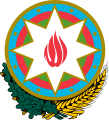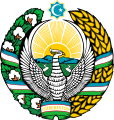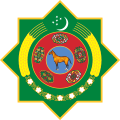Rub al-Hizb
This article needs additional citations for verification. (March 2024) |
| ۞ | |
|---|---|
Rub al-Hizb | |
| In Unicode | U+06DE ۞ ARABIC START OF RUB EL HIZB |
The Rub al-Hizb (Arabic: ربع الحزب, romanized: Rubʿ al-Ḥizb, lit. 'quarter of the party') is an Islamic symbol in the shape of an octagram, represented as two overlapping squares ۞. While its main utility today is to mark a division inside some copies of the Quran to facilitate recitation, it has originally featured on a number of emblems and flags in the past and continues to do so today.
Name[edit]
The term Rubʿ al-Ḥizb in Arabic translates as "quarter of the party". The Quran is divided into 60 aḥzāb (grouped into 30 ajzāʾ), the Rub al-Hizb further dividing each ḥizb into four, for a total of 240 divisions.
History[edit]
What would become Rub al-Hizb was originally the symbol with which the Tartessos, since remote Neolithic times, made offerings to the Sun and represented it with eight rays. By the time of Al-Andalus in the Iberian Peninsula, it had defined as a cultural symbol, appearing on the coins. In addition, the use of it in so many areas[which?] led to being called the star of Emir Abd al-Rahman I (r. 731–788). From Al-Andalus it was exported to the rest of the Arab world. It has also been used extensively in Turkic Islamic culture and history.[1][2]
Variants[edit]
-
Interlaced
-
Outline
Contemporary use[edit]
Architecture[edit]

The symbol has been used as a basis for plans of buildings, as in the case of the Petronas Towers.
Former flags[edit]
-
Purported flag of the Marinid Sultanate (1258–1659)
-
Flag of Egypt (1793–1844)
-
An Ottoman flag with an eight pointed star (after 1844)
-
Flag of the Emirate of Afghanistan (1919–1926)
Current flags[edit]
-
Standard of the President of Turkmenistan
-
Standard of the President of Uzbekistan
Emblems[edit]
References[edit]
- ^ "Eight-Pointed Star Meaning". Antique Rugs by Doris Leslie Blau. 2019-02-01. Retrieved 2023-09-11.
- ^ REKI, ARSLAN SELÇUK, Mahina, Semra (2018-05-22). "EVOLUTION OF GEOMETRIC PATTERNS IN ISLAMIC WORLD AND A CASE ON THE JALIS OF THE NAULAKHA PAVILION IN THE LAHORE FORT". Gazi University Journal of Science. B (6(1)): 83–97 – via https://dergipark.org.tr/.
{{cite journal}}: External link in|via= - ^ Galal Abada (2004). "Petronas Office Towers" (PDF). Kuala Lumpur, Malaysia. Archived from the original on 2012-10-01.
{{cite web}}: CS1 maint: unfit URL (link)















